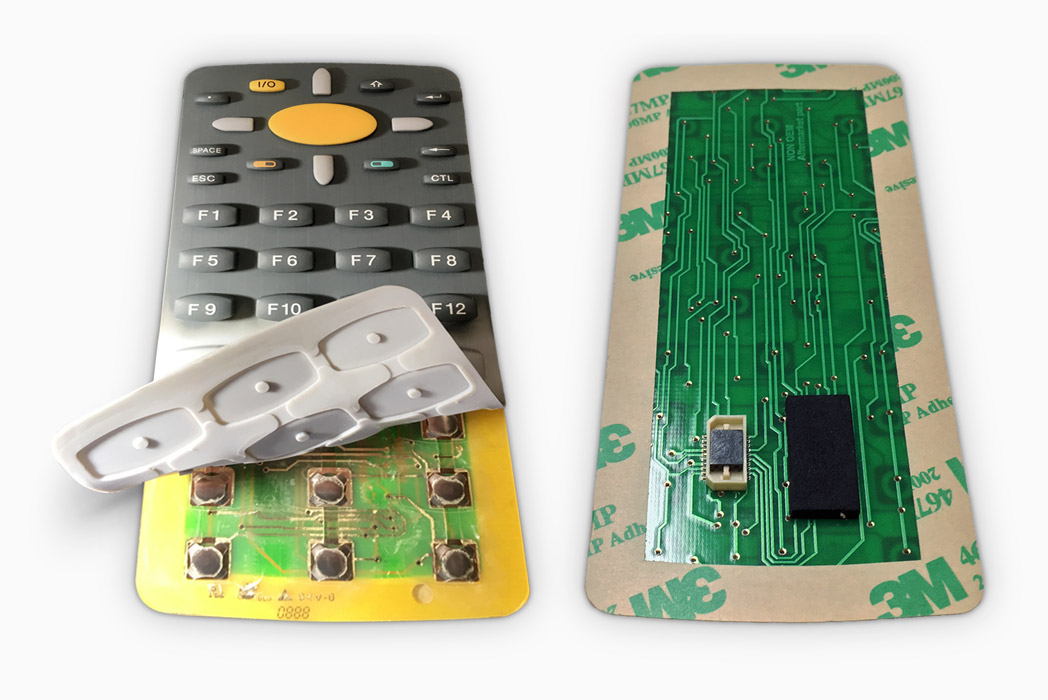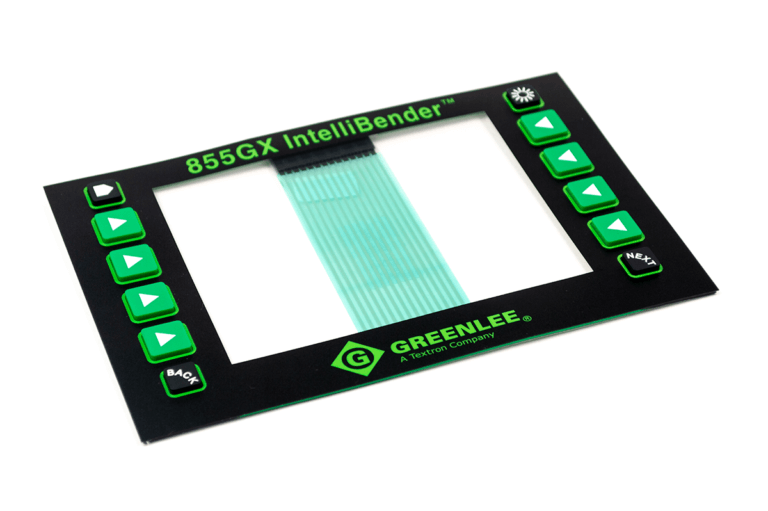Discovering the Manufacturing Refine Behind Rubber Keypads and Their Importance in Modern Instruments
Rubber keypads are crucial in the functionality of modern-day gadgets. Their production process entails mindful selection of products and accurate strategies. Keypads are made to improve user interaction while making sure durability and integrity. Recognizing how these elements are made reveals their significance across numerous applications. What factors add to their performance, and exactly how do these elements influence individual experience? The answers may reshape perceptions of this daily modern technology.
Summary of Rubber Keypads and Their Applications

Rubber keypads are versatile parts extensively made use of in various digital devices, varying from customer electronics to industrial devices. Their layout enables a tactile response, making them an optimal choice for applications calling for user interaction. Frequently discovered in items such as remote controls, calculators, and clinical gadgets, rubber keypads assist in ease of usage and availability.
In industrial settings, they serve important features in machinery and control board, where longevity and resistance to ecological factors are necessary. The non-slip surface area enhances grasp, promoting integrity sought after problems. Additionally, their lightweight nature and adjustable forms allow suppliers to create customized services that fit specific requirements. With innovations in modern technology, rubber keypads continue to advance, incorporating functions like backlighting and boosted level of sensitivity. On the whole, their flexibility and useful benefits contribute greatly to the performance of various devices across several markets.
Products Used in Rubber Keypad Production
Keypad making counts on a choice of products that improve both performance and resilience. The key material used in the manufacturing of rubber keypads is silicone rubber, known for its superb resilience and adaptability. This product permits keypads to withstand repeated pressing without shedding form or efficiency. Furthermore, polycarbonate elastomers (TPE) are frequently used as a result of their convenience of molding and ability to supply a soft-touch feel.
Tinting representatives, such as pigments, are incorporated to guarantee vibrant, resilient shades that improve visual allure. Moreover, ingredients like anti-UV representatives and flame resistants may be mixed into the rubber to boost weather resistance and safety conformity. The selection of products directly influences the keypad's tactile action, durability, and total efficiency in various gadgets. Eventually, the mindful option of these elements is vital for the manufacturing of high-quality rubber keypads that meet consumer and industry demands.
The Design Refine of Rubber Keypads
When producing rubber keypads, the design process plays a crucial duty in identifying capability and individual experience. Developers begin by defining the keypad's intended usage, taking into consideration aspects such as the gadget it will come with and the target customer demographic. This first stage consists of sketching formats that focus on ergonomic elements, ensuring the secrets are quickly accessible and appropriately spaced.
Next off, developers focus on the tactile feedback preferred from the keypads, which affects the choice of materials and key forms. Prototyping is essential in this stage, enabling designers to examine numerous designs for comfort and responsiveness.
Manufacturing Techniques for Rubber Keypads
The manufacturing procedure for rubber keypads entails a series of accurate methods that guarantee top quality and performance. Initially, liquid silicone rubber (LSR) is typically utilized as a result of its resilience and flexibility. The procedure starts with blending the raw materials, including silicone, colorants, and treating agents. This mix is after that infused right into molds made to form the keypads properly.
Complying with injection, the shaped keypads go through treating, a home heating procedure that strengthens the product (Rubber Keypads). This is generally executed in a press, making certain the keypads accomplish the desired solidity and durability

High Quality Control Measures in Manufacturing
To guarantee that rubber keypads satisfy high standards of high quality and capability, rigorous quality assurance measures are applied throughout the production procedure. These actions begin with basic material inspection, making certain that just the highest-grade elastomers are made use of. Throughout the production phase, drivers conduct normal checks to monitor criteria such as temperature level, stress, and blending times, critical for accomplishing regular product top quality.
Post-production, each set of keypads undertakes detailed screening, consisting of responsive action evaluations and sturdiness tests to assess performance under various conditions. Aesthetic inspections are also conducted to recognize any issues, such as bubbles or inconsistencies in appearance. Furthermore, compliance with market requirements is verified, making sure that pop over to these guys the keypads satisfy security and capability criteria.
The Duty of Innovation in Keypad Growth
Technology plays a crucial function in the development of rubber keypads by allowing sophisticated manufacturing methods that improve precision and efficiency. In addition, ingenious material selection enables enhanced longevity and responsiveness in keypad performance. These developments not just improve manufacturing yet likewise raise the general top quality of the final item.
Advanced Manufacturing Techniques
Advancements in manufacturing methods change the production of rubber keypads, boosting both effectiveness and accuracy. Technologies such as shot molding and 3D printing have transformed conventional procedures, making it possible for manufacturers to create complex layouts with decreased waste and improved turnaround times. Automation plays an essential role in this development, improving production line and decreasing human error. Additionally, computer-aided style (CAD) software program enables complex modification, making certain that keypads satisfy details customer needs. Quality assurance actions have likewise advanced, incorporating real-time tracking systems that identify flaws early in the manufacturing cycle. These innovations not just boost the sturdiness and functionality of rubber keypads yet additionally support the growing demand for tailored services in various industries, from consumer electronics to automobile applications.
Ingenious Material Option
The development of making strategies has led the way for ingenious product option in rubber keypad growth. Breakthroughs in polymer scientific research have actually presented products that improve longevity, flexibility, and responsive responses. Makers now utilize polycarbonate elastomers (TPE) and silicone substances, which provide superior resistance to put on and environmental aspects. These products enable the development of keypads that can withstand extended usage while maintaining aesthetic allure. In addition, the combination of additives and layers boosts capability, such as boosting grasp and decreasing friction. The choice of materials is essential, as it straight impacts the efficiency and longevity of keypads in numerous devices, from customer electronic devices to industrial devices. This innovative strategy remains to form the future of keypad layout and use.
The Effect of Rubber Keypads on User Experience
Rubber keypads substantially influence individual experience via their improved responsive reaction, which permits for more accurate interaction. In addition, their durability and durability add to consistent efficiency gradually, decreasing the demand for regular substitutes. This combination of attributes makes rubber keypads a favored selection in various applications, ultimately influencing user complete satisfaction.
Boosted Tactile Reaction
Enhancing tactile response greatly influences individual experience, especially in tools that rely on keypads for interaction. Rubber keypads give a distinct mix of soft qualities and strength, allowing users to really feel unique responses with each press. This feedback strengthens a sense of control and precision, essential in applications varying from smart devices to commercial tools. Individuals commonly report greater fulfillment and effectiveness when connecting with tools that feature well-designed rubber keypads, as they promote quicker and more accurate input. Furthermore, the ergonomic design of these keypads can reduce finger exhaustion, advertising longer use periods without pain. Generally, the enhanced responsive action given by rubber keypads substantially adds to an extra user-friendly and satisfying customer experience in contemporary technology.
Longevity and Longevity
A key facet of individual experience with rubber keypads depends on their resilience and longevity. These keypads visite site are created to withstand comprehensive usage, withstanding deterioration that typically impacts other products. The robust nature of rubber warranties that keypads keep their performance and look in time, which is essential for gadgets frequently used in different environments. Individuals gain from the dependability of rubber keypads, as they can endure direct exposure to wetness, temperature, and dirt changes without wearing away. This resilience not only improves customer fulfillment yet also decreases the demand for constant replacements, eventually adding to cost-effectiveness for suppliers. Essentially, the resilience of rubber keypads greatly affects the total performance and customer experience in contemporary gadgets.
Frequently Asked Questions
Exactly How Lengthy Do Rubber Keypads Commonly Last in Tools?
Rubber keypads usually last in between 5 to 10 years, depending upon use, ecological elements, and top quality of products used click now (Rubber Keypads). Routine damage can reduce their life-span, influencing capability and user experience with time
Can Rubber Keypads Be Personalized for Certain Applications?
Rubber keypads can certainly be personalized for details applications, allowing alterations in size, shade, form, and structure. This adaptability allows manufacturers to develop customized services that satisfy diverse individual demands and improve capability in numerous devices.
Are Rubber Keypads Ecologically Friendly?
Rubber keypads are commonly not considered eco-friendly because of their petroleum-based materials. Nonetheless, improvements in lasting manufacturing practices and the growth of bio-based options are progressively enhancing their eco-friendly influence in numerous applications.
What Are Typical Issues Encountered During Rubber Keypad Manufacturing?
Common concerns dealt with throughout rubber keypad manufacturing consist of inconsistent worldly quality, mold and mildew defects, improper healing times, adhesion failings, and difficulties in accomplishing precise responsive feedback. These troubles can result in lowered item performance and customer frustration.
Just How Do Rubber Keypads Compare to Other Kinds of Secret Switches Over?
Rubber keypads use a softer feel and quieter operation contrasted to mechanical switches, which offer tactile responses. Rubber keypads may use out faster and do not have the accuracy that some customers prefer in high-performance applications.
The main product utilized in the manufacturing of rubber keypads is silicone rubber, understood for its superb durability and versatility. When creating rubber keypads, the style process plays a vital function in figuring out capability and individual experience. Rubber keypads considerably influence individual experience through their enhanced tactile feedback, which allows for more exact interaction. Individuals often report higher satisfaction and effectiveness when communicating with gadgets that feature well-designed rubber keypads, as they help with quicker and much more accurate input. A crucial aspect of individual experience with rubber keypads lies in their longevity and long life.